Escherichia coli and Staphylococcus aureus elicit differential innate immune responses following intramammary infection
- PMID: 15138171
- PMCID: PMC404560
- DOI: 10.1128/CDLI.11.3.463-472.2004
Escherichia coli and Staphylococcus aureus elicit differential innate immune responses following intramammary infection
Abstract
Staphylococcus aureus and Escherichia coli are among the most prevalent species of gram-positive and gram-negative bacteria, respectively, that induce clinical mastitis. The innate immune system comprises the immediate host defense mechanisms to protect against infection and contributes to the initial detection of and proinflammatory response to infectious pathogens. The objective of the present study was to characterize the different innate immune responses to experimental intramammary infection with E. coli and S. aureus during clinical mastitis. The cytokine response and changes in the levels of soluble CD14 (sCD14) and lipopolysaccharide-binding protein (LBP), two proteins that contribute to host recognition of bacterial cell wall products, were studied. Intramammary infection with either E. coli or S. aureus elicited systemic changes, including decreased milk output, a febrile response, and induction of the acute-phase synthesis of LBP. Infection with either bacterium resulted in increased levels of interleukin 1beta (IL-1beta), gamma interferon, IL-12, sCD14, and LBP in milk. High levels of the complement cleavage product C5a and the anti-inflammatory cytokine IL-10 were detected at several time points following E. coli infection, whereas S. aureus infection elicited a slight but detectable increase in these mediators at a single time point. Increases in IL-8 and tumor necrosis factor alpha were observed only in quarters infected with E. coli. Together, these data demonstrate the variability of the host innate immune response to E. coli and S. aureus and suggest that the limited cytokine response to S. aureus may contribute to the well-known ability of the bacterium to establish chronic intramammary infection.
Figures
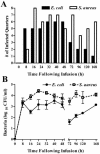
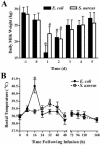
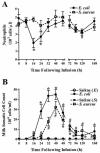

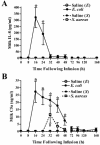
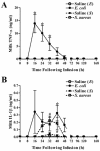
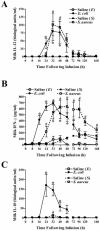
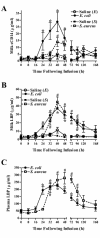
References
-
- Aderem, A., and R. J. Ulevitch. 2000. Toll-like receptors in the induction of the innate immune response. Nature 406:782-787. - PubMed
-
- Agrawal, S., A. Agrawal, B. Doughty, A. Gerwitz, J. Blenis, T. Van Dyke, and B. Pulendran. 2003. Cutting edge: different Toll-like receptor agonists instruct dendritic cells to induce distinct Th responses via differential modulation of extracellular signal-regulated kinase-mitogen-activated protein kinase and c-Fos. J. Immunol. 171:4984-4989. - PubMed
-
- Alluwaimi, A. M., C. M. Leutenegger, T. B. Farver, P. V. Rossitto, W. L. Smith, and J. S. Cullor. 2003. The cytokine markers in Staphylococcus aureus mastitis of bovine mammary gland. J. Vet. Med. B 50:105-111. - PubMed
-
- Amir, L. H., H. Harris, and L. Andriske. 1999. An audit of mastitis in the emergency department. J. Hum. Lact. 15:221-224. - PubMed
MeSH terms
Substances
LinkOut - more resources
Full Text Sources
Other Literature Sources
Research Materials
Miscellaneous

